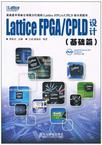Lattice FPGA/CPLD设计
出版时间:2011-1 出版社:人民邮电出版社 作者:梁成志 主编,王诚,赵延宾 编著 页数:430
Tag标签:无
前言
Both CPLDs (complex programmable logic device) and FPGAs (field programmable gate array) were invented approximately 25 years ago. However, it is only within the past decade that these versatile, reprogrammable logic ICs have become a force to be reckoned with in system design. Where once programmable devices were used primarily for glue logic applications or in the development of prototype designs, today's CPLDs, and particularly FPGAs, have evolved into high-performance low-power chips with advanced IO, memory, DSP blocks, SERDES transceivers and processing resources that make them viable choices for volume production in infrastructure markets such as wireline and wireless.At the same time that programmable logic devices have become less expensive and more capable, ASICs (application-specific integrated circuits) have become prohibitively expensive, and ASSPs (application-specific standard products) too inflexible for product life cycles that often are measured in months. As a result, the use of programmable logic is expanding to applications and within markets (such as consumer) where previously they were not realistic design choices. This is certainly true of the programmable logic devices offered by Lattice Semiconductor, including their PLDs, FPGAs and programmable Power Management and Clock Management mixed signal devices.The ispMACH 4000ZE CPLDs, for example, are being used in portable, handheld device design applications due to their low power consumption and small size.The Lattice MachXO PLD devices are versatile, "all in one" PLDs that are easy and convenient to design with. Lattice's mid-range ECP3 FPGA families are setting new standards for low powerand high value in wireless, wireline, display and security and surveillance applications. Complementing Lattice's silicon devices is an extensive ecosystem of design tools, reference designs, IP cores, development kits and evaluation boards.
内容概要
本书是由lattice公司技术专家编写、审校而成的国内第一本系统介绍lattice器件及工具软件的书籍,弥补了目前国内没有权威的中文lattice器件和工具软件书的空白(本书为“基础篇”,随后将会编辑出版“高级篇”)。本书结合作者十多年的工作经验,系统地介绍了fpga/cpld的基本设计方法,lattice主流fpga/cpld的结构与特点,lattice工具软件以及设计流程,lattice器件相关的常用调试手段和技巧,lattice提供的系统解决方案等。 本书配套光盘中收录了isplever starter软件以及书中所有实例的完整工程文件、设计源文件,并提供了部分lattice器件的技术手册,便于读者边学边练,提高实际应用能力。 本书可作为硬件工程师和逻辑工程师的实用工具书,也可以作为高等院校通信工程、电子工程、计算机、微电子与半导体等专业的教材和课外辅导书籍。
书籍目录
第1章 fpga/cpld简介 1.1 可编程逻辑设计技术简介 1.1.1 可编程逻辑器件发展简史 1.1.2 可编程逻辑器件的分类 1.2 fpga/cpld的基本结构 1.2.1 fpga的基本结构 1.2.2 cpld的基本结构 1.2.3 fpga和cpld的比较 1.3 fpga/cpld的设计流程 1.4 fpga/cpld的常用开发工具 1.5 下一代可编程逻辑设计技术展望 1.5.1 下一代可编程逻辑器件硬件上的发展趋势 1.5.2 下一代eda软件设计方法发展趋势 1.6 小结 1.7 问题与思考 第2章 lattice可编程逻辑器件的结构和特点 2.1 cpld器件 2.1.1 ispmach 4000 cpld的结构和特点 2.1.2 未来cpld的替代产品machxo 2.1.3 machxo2系列器件 2.2 fpga器件 2.2.1 非易失(non-volatile)xp/xp2系列fpga 2.2.2 高性价比的ecp2m/ecp3系列fpga 2.2.3 即将面世的ecp4系列fpga 2.3 可编程数模混合器件 2.3.1 可编程电源管理芯片的结构和特点 2.3.2 可编程时钟管理芯片的结构和特点 2.4 小结 2.5 问题与思考 第3章 isplever fpga开发流程入门 第4章 isplever fpga开发流程进阶 第5章 lattice常用辅助设计工具 第6章 lattice fpga/cpld的加载配置 第7章 lattice ip开发工具 第8章 第三方eda工具 第9章 lattice系列fpga开发系统
章节摘录
插图:
编辑推荐
《Lattice FPGA/CPLD设计(基础篇)》:莱迪思半导体公司倾力打造的Lattice FPEGA/CPLD设计类图书。
图书封面
图书标签Tags
无
评论、评分、阅读与下载
用户评论 (总计3条)
- 但是这本书说了很多没有用的废话,市场上本来关于lattice的书和资料就很少,而这本书基本用处不大,不管从任何方面来说。主要讲的就是废话!
- 书中讲的是ISPLEVER软件,目前已经不能在官网上下载,且配送的软件没有Synplify和Active-HDL,学习的部分内容无法应用。新一代软件Lattice Diamond书中几乎没有讲解,有点遗憾。希望高级版能改善
- lattice技术专家写的 很实用,很有启发性。 建议买回去看看
推荐图书
- 新农村科普知识
- 青少年爱玩的魔术全集
- 高职高水平大专大气象
- 阅读大中国
- 考研英语阅读题源Ⅱ 经济学家
- 考研英语阅读题源2
- 考研英语阅读题源2
- 80天攻克雅思口语、听力、写作词汇放口袋
- 80天攻克雅思阅读词汇放口袋
- 高中生雅思预科作文母题40篇
- 应用文写作
- 盐碱地上的挣扎
- 美国人在读什么
- 美国人在读什么 青春飞扬的畅销书
- 美国人在读什么 风云人物追捧的商务书
- 新托福词汇七法合一速记
- Step by Step畅听VOA慢速新闻英语
- 新雅思词汇七法合一速记
- 80天攻克雅思词汇一本全放口袋
- 高中生雅思预科词汇大全
- 考研英语阅读题源Ⅱ 纽约时报
- 机械认知实践
- 沉积学
- 富油凹陷隐蔽型潜山油气藏精细勘探
- 辉煌见证
相关图书
- Adobe Dreamweaver CS5中文版经典教程
- 中文版AutoCAD 2010辅助设计208例
- 最香港
- 胡老师教你识读电子电路图
- 水晶石技法3ds Max/VRay室内空间表现2
- 胡老师教你识读电源电路图
- 财务管理
- ADOBE ILLUSTRATOR CS5标准培训教材
- 动漫秀场23
- Photoshop CS5中文版完全自学手册
- 油气藏增产新技术
- 最杭州
- 电动机维修技能7日通
- 长庆油田企业经营管理
- 门老师教你快速看懂电子电路图
- Adobe Illustrator CS5中文版经典教程
- 超人气网站是这样建成的
- CG绘画实战技法3
- Adobe InDesign CS5中文版经典教程
- 石油石化消防指战员培训教程
- 第九界石油钻井院所长会议论文集
- 石油机械基础
- 地球科学概论
- 跨国石油投资与并购
- 信息资源检索与利用
